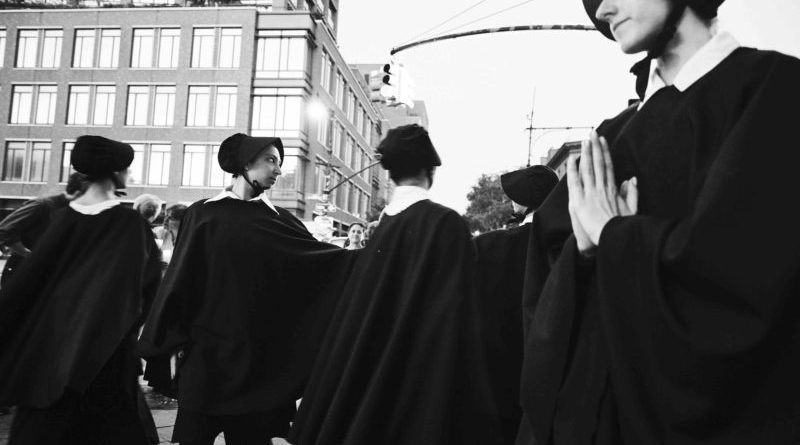INTERVIEW: New theater piece remembers St. Vincent’s Hospital with tour of West Village
Photo: Novenas for a Lost Hospital tells the story of St. Vincent’s Hospital in New York City. Photo courtesy of Mark Abrahams / Provided by Everyman Agency with permission.
The legendary St. Vincent’s Hospital in Greenwich Village was a health-care facility that experienced history for decades upon decades. The institution and its staff members served victims from the Titanic, patients of the HIV/AIDS crisis and survivors of 9/11, and the many events in between.
Today St. Vincent’s is but a memory, with the original hospital building demolished a few years ago. But playwright Cusi Cram would like to honor the legacy of this Roman Catholic health-care facility.
Cram’s new play, Novenas for a Lost Hospital, attempts to remember St. Vincent’s, and Rattlestick Playwrights Theater, which is staging the show from Sept. 5 to Oct. 13, is not simply setting up the spotlights and readying the curtain. Novenas actually takes place in a couple locations in the West Village, making for a truly immersive experience.
Kathleen Chalfant plays Saint Elizabeth Seton, who guides 60 audience members from an enclosed garden to the New York City AIDS Memorial Park to the Rattlestick theater space. All the while, the theatrical project attempts to resurrect memories of an institution that was a mainstay in the Village for generations.
Recently Hollywood Soapbox exchanged emails with Cram about the new play. Questions and answers have been slightly edited for style.
What inspired you to write this play?
Until very recently, I lived in the West Village, a few blocks away from the hospital for over 25 years. And like many people in the community, I felt the sting of the closing of the hospital. It felt like a real a seismic shift to the neighborhood and the city.
When Daniella Topol became the artistic director of Rattlestick, I told her about my longtime obsession with walking tours and how I had created several pieces which were historical/dramatic hybrids — essentially walking tours where all sorts of surprising staged things happened. She was incredibly intrigued by this, and we made a piece together, where we staged a walking tour around longtime Village residents’ memories of the Village.
And whenever the tour arrived at Bank Street and Greenwich Avenue, across from where the hospital used to be, people on the tour would erupt into all kinds of conflicted feelings about the closing of St. Vincent’s. The closing still felt very alive to everyone. Daniella and I decided there might be a play to write around all those hot and unprocessed feelings.
Did you have to conduct a lot of research into St. Vincent’s Hospital?
The research process has been quite extensive. The play spans 161 years of history, so I had to delve into all kinds of areas of New York history that were new to me. I worked with an extraordinary dramaturg, Guy Lancaster, who read and researched a huge swath of subjects for me, and then he would give me particular things to read. And we would distill that information together, to figure out what could be transformed into scenes and eventually build a story. More than any other piece I have written, this play was written very collaboratively, mostly with Guy Lancaster and Daniella Topol. We talked a lot about history and the themes that intrigued us both before and after I wrote.
The locations where this production will be staged are quite unique. When did that idea come to you?
This idea emerged out of a passion/obsession of mine to have theater interact with the streets of the Village. I love having the drama of New York street life interact with theatrical drama. I also think ending the play at the New York City AIDS Memorial makes a lot of sense, visually and from a storytelling perspective, as the hospital was an epicenter of the AIDS crisis and looks out on the former hospital.
What are some of the unique considerations you and Rattlestick have to think about for a play that moves around the neighborhood?
Moving 60 people from place to place is tricky. One of the things I think about the most is how you keep people engaged with the play, when it is on the street. New York’s streets are incredibly distracting and noisy! And you never quite know what is going to happen, so you have to be flexible about that. I think using movement and music helps. We also want whatever is happening outside the theater to be echoed but not repeated inside the theater. Each of the components have to speak to each other.
What has it been like working with Kathleen Chalfant and Daniella Topol?
Both Kathy and Daniella are dreamy collaborators. To my mind, Kathy is one of the best actresses in New York. She brings this unusual combination of keen intelligence and deep compassion into any room she in. She also has incredible technical skills. There is something about the way she colors language with her voice that is completely thrilling.
I have learned so much from Daniella as a collaborator. She is such an amazing community builder. She thinks so deeply about the spaces she creates. Her rehearsal room is so free and open. It feels safe and exciting. She also is wonderful with actors; they really trust her. She pushed me to write this play, and I am so grateful for that push as it has led me into a whole other way of making and thinking about theater.
By John Soltes / Publisher / John@HollywoodSoapbox.com
Novenas for a Lost Hospital will play Sept. 5 to Oct. 13 at the Rattlestick Playwrights Theater in New York City. Click here for more information and tickets.

